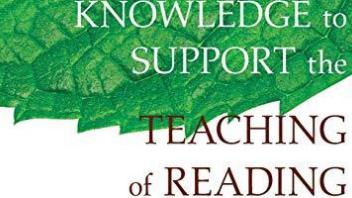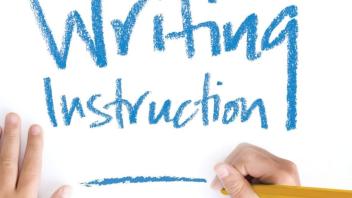Featured booklists
Themed Booklist
Teaching Reading
Themed Booklist
The Cognitive Science of Reading
Themed Booklist
Reading Motivation and Reading Aloud
Themed Booklist
Teaching Writing
Themed Booklist
Learning Differences
Themed Booklist
In the Classroom: Teaching Children on the Autism Spectrum
Themed Booklist
About Autism: Books for Parents and Educators
Adult Education Books

This book uses photographs of students engaging in a variety of real-life social situations. The realistic format plays to the visual strengths of children with ASD to teach appropriate social behaviors. Color photographs illustrate the “right way” and “wrong way” to approach each situation and the positive/negative consequences of each. A facilitator (parent, teacher, etc.) is initially needed to explain each situation, and ask questions such as “What is happening in this picture?” Children role-play skills until confident enough to practice them in real-life interactions.
The Social Skills Picture Book

Since the early 90s, Gray’s world-famous Social Stories have helped thousands of children with autism spectrum disorders. This 15th Anniversary Edition of her best-selling book offers ready-to-use stories that parents and educators have depended on for years, and new sections added are: How to most effectively use and apply the stories; How to improve the lives of younger children; and Social Stories for teens and adults with autism. Developed through years of experience, these strategically written stories explain social situations in ways children and adults with autism understand, while teaching social skills needed for them to be successful at home, school, work, and in the community.
The New Social Story Book

One look at the table of contents and you’ll likely recognize behaviors you deal with on a daily basis like “Bumping Into Other Students,” “Breaking Pencils” and “Difficulty Lining Up.” The solutions are practical and positive and explain the reasons behind the sometimes challenging behavior. Written by a pediatric occupational therapist, a parent of a child with autism and a director of special education, this guide has practical tips for teaching students with autism. This book is designed to be an at-your-fingertips resource. You can quickly consult the table of contents to find the section on the issue, learn what is potentially at the root of the behavior, and find possible solutions to implement immediately.
Behavior Solutions for the Inclusive Classroom

This New York Times best-selling memoir offers a sometimes humorous, sometimes heartbreaking look at what it’s like to grow up with Asperger’s syndrome in a time before there was much understanding of Asperger’s or autism. The author’s stories of his childhood will offer some understanding when it comes to some of the things your students with autism might be feeling and experiencing. You might find yourself laughing as you read the author’s anecdotes about his efforts to navigate the adult world as a person with Asperger’s.
Look Me in the Eye: My Life With Asperger’s

You’re guaranteed to find workable solutions for your classroom in this book of 1,001 (actually 1,800) ideas for working with kids who have autism or Asperger’s. It includes sections for helping with sensory integration, ideas for supporting communication and language, tips for managing challenging behavior, ideas for teaching daily living skills, and strategies for teaching social skills. You can look through the table of contents, target the issue you need to address and find a variety of potential solutions. This book has won numerous awards and is a must-have reference tool for your classroom bookshelf.
1001 Great Ideas for Teaching and Raising Children with Autism or Asperger’s

Temple Grandin may be the most famous person with autism. Weaving her own experience with remarkable new discoveries, Grandin introduces the advances in neuroimaging and genetic research that link brain science to behavior, even sharing her own brain scan to show which anomalies might explain common symptoms. She argues that raising and educating kids on the autism spectrum must focus on their long-overlooked strengths to nurture their unique contributions. Grandin discusses different ways of thinking and even includes lists of potential jobs for those people among us who think differently. An important and ultimately optimistic work.
The Autistic Brain: Helping Different Kinds of Minds Succeed

This groundbreaking book by Dr. Temple Grandin, professor of animal science at Colorado State University, was one of the first to help neurotypical adults understand autism from a first-person point of view. She gives you a peek into her own psyche to help you understand how your child or students with autism might process information. Her explanation of how she sees the world in pictures will change how you relate to people with autism. Temple offers helpful dos and don’ts, practical strategies, and try-it-now tips, all based on her insider perspective and a great deal of research.
The Way I See It: A Personal Look at Autism and Asperger’s
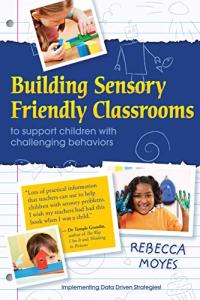
Teachers know that half the challenge of teaching is setting up an effective learning environment. This book is designed to help you structure your classroom so that even kids who struggle with sensory overload (like many kids with autism do) will feel comfortable. The author places an emphasis on using data from student observations to craft a classroom that will support your specific students and their needs.
Building Sensory Friendly Classrooms to Support Children with Challenging Behaviors

An an essential “literacy meets autism” primer for general educators and reading specialists, this book provides the know-how for bringing quality, meaningful literacy instruction to students with autism in grades K-12. Teachers will learn research-based practices in reading and writing instruction; ideas for planning lessons, differentiating instruction, and designing a classroom environment that promotes literacy learning while addressing the individual needs of learners with autism; techniques for assessing students who cannot show their literacy learning in traditional ways due to communication or learning differences; and much more from the authors’ own extensive classroom experience.
A Land We Can Share: Teaching Literacy to Students with Autism

When learners with autism have deep, consuming fascinations — trains, triangles, basketballs, whales — teachers often wonder what to do. This concise, highly practical guidebook gives educators across grade levels a powerful new way to think about students’ “obsessions” — as positive teaching tools that calm, motivate, and improve learning. Written by top autism experts and nationally renowned speakers Kluth and Schwarz, this guide is full of easy tips and strategies for folding students’ special interests, strengths, and areas of expertise into classroom lessons and routines.
Just Give Him the Whale! 20 Ways to Use Fascinations, Areas of Expertise, and Strengths to Support Students with Autism
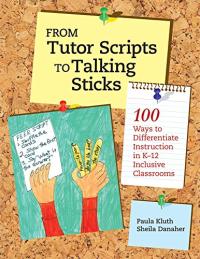
These ready-to-use, research-based adaptations enhance motivation and improve achievement for all children — including English-language learners and students with autism, emotional disabilities, cognitive disabilities, learning disabilities and other special needs. Includes easy adaptations in 10 key areas: organization; environment and sensory; technology; communication and participation; behavior and motivation; teaching and learning; literacy; math; study and review; and assessment
From Tutor Scripts to Talking Sticks: 100 Ways to Differentiate Instruction in K-12 Inclusive Classrooms
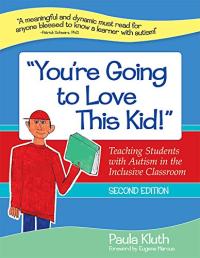
Find fresh ways to welcome and teach students with autism. The book includes forms, checklists, and planning tools that make it easy for teachers to implement the suggested strategies; photos of curricular adaptations, sensory supports, and classroom scenes; and tips on improving literacy, implementing positive behavior support, and collaborating effectively with families. This updated edition also includes information on fostering friendships, building communication skills, planning challenging and multidimensional lessons, and adapting the curriculum and the physical environment.
You’re Going to Love This Kid! Teaching Students with Autism in the Inclusive Classroom

Psychologist and educator Armstrong illuminates a new understanding of neuropsychological disorders. He argues that if they are a part of the natural diversity of the human brain, they cannot simply be defined as illnesses. Armstrong explores the evolutionary advantages, special skills, and other positive dimensions of these conditions. A manifesto as well as a keenly intelligent look at “disability,” this book is an important read for parents, teachers, and anyone who is “differently brained.”
The Power of Neurodiversity: Unleashing the Advantages of Your Differently Wired Brain

This book offers a deep understanding and a more humane approach to autism. Instead of classifying “autistic” behaviors as signs of pathology, autism expert Dr. Prizant sees them as part of a range of strategies to cope with a world that feels chaotic and overwhelming. Rather than curb these behaviors, it’s better to enhance abilities, build on strengths, and offer supports that will lead to more desirable behavior and a better quality of life. “This is by far the most empathic, wise, and insightful book I have ever read about autism, and is one of the most empathic and wise books I’ve ever read about being human.”
Uniquely Human: A Different Way of Seeing Autism

This best-selling book tells the story of Leo Kanner and Hans Asperger, the research pioneers who defined the scope of autism in profoundly different ways; and then goes on to explore the game-changing concept of neurodiversity. It considers the idea that neurological differences such as autism, dyslexia, and ADHD are not errors of nature or products of the toxic modern world, but the result of natural variations in the human genome. This groundbreaking book will reshape our understanding of the history, meaning, function, and implications of neurodiversity in our world.
NeuroTribes: The Legacy of Autism and the Future of Neurodiversity

Imagine being trapped inside a Disney movie and having to learn about life mostly from animated characters dancing across a screen of color. A fantasy? A nightmare? This is the real-life story of Owen Suskind, the son of the Pulitzer Prize-winning journalist Ron Suskind and his wife, Cornelia. An autistic boy who couldn’t speak for years, Owen memorized dozens of Disney movies, turned them into a language to express love and loss, kinship, brotherhood.The family was forced to become animated characters, communicating with him in Disney dialogue and song; until they all emerge, together, revealing how, in darkness, we all literally need stories to survive.
Life, Animated: A Story of Sidekicks, Heroes, and Autism

A great resource for educators, behavior specialists, early interventionists, SLPs, occupational therapists, and families, this reader-friendly pocket guide is the perfect introduction to Pivotal Response Treatment (PRT), the popular approach that uses natural learning opportunities to modify pivotal areas of behavior. Pioneering autism experts Robert and Lynn Koegel speak directly to the reader, demystifying PRT and clearly explaining why it leads to widespread and rapid progress for children.
The PRT Pocket Guide: Pivotal Response Treatment for Autism Spectrum Disorders

With an estimated half a million Americans under twenty-six on the autism spectrum, this book offers the reassurance, solace, and practical solutions that so many people are searching for. Following up on their work in Overcoming Autism, which offered advice for teaching young children on the spectrum, Koegel and LaZebnik now present strategies for working with teens and young adults living with this complex condition. The book addresses universal parental concerns, from first crushes and a changing body to how to succeed in college and beyond,
Growing Up on the Spectrum: A Guide to Life, Love, and Learning for Teens and Young Adults with Autism and Asperger’s

Lynn Kern Koegel, the nationally recognized head of the Autism Research Center at the University of California, and Claire LaZebnik, a professional writer and the mother of a child with autism, have updated their classic guide with today’s cutting-edge research. This revised edition has also been expanded to clarify the importance of community support to affected families and the effect of societal acceptance on a child’s life.
Overcoming Autism: Finding the Answers, Strategies, and Hope That Can Transform a Child’s Life

The book takes readers through homes, classrooms, e-book publishers, research labs, and the app marketplace to show how educators and parents can help children grow into strong, passionate readers using media of all kinds — print, digital, and everything in between. Tap, Click, Read includes an analysis of the exploding app marketplace and provides useful information on new review sites and valuable curation tools. It shows what to avoid and what to demand in today’s apps and e-books — as well as what to seek in community preschools, elementary schools and libraries. Peppered with the latest research from fields as diverse as neuroscience and behavioral economics and richly documented examples of best practices from schools and early childhood programs around the country, the book will show you how to: promote the adult-child interactions that help kids grow into strong readers; learn how to use digital media to build a foundation for reading and success; and discover new tools that open up avenues for creativity, critical thinking, and knowledge-building that today’s children need
Tap, Click, Read
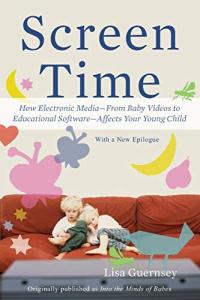
Advocating a new approach to screen time, Guernsey focuses on infants to five-year-olds and goes beyond the headlines to explore what exactly is “educational” about educational media. She examines how play and language development are affected by background and foreground television and how to choose videos that are age-appropriate. She explains how to avoid the hype of “brain stimulation” and focus instead on social relationships and the building blocks of language and literacy. Along the way, Guernsey highlights independent research on shows ranging from Dora the Explorer to Dragon Tales, and distills some surprising new findings in the field of child development. Parents, teachers, and psychologists will be relieved to learn positive approaches to using videos with young children and will be empowered to make their own informed choices.
Screen Time: How Electronic Media — From Baby Videos to Educational Software — Affects Your Young Child

Black and Latino boys face persistent and devastating disparities in achievement when compared to their white counterparts. Schooling for Resilience investigates how seven newly formed schools, created specifically to serve boys of color, set out to address the broad array of academic and social problems faced by Black and Latino boys. Drawing on student and teacher surveys, focus groups, interviews, and classroom observations, the authors investigate how these schools were developed, what practices they employed, and how their students responded academically and socially. In particular, they focus on the theory of action that informed each school’s approach to educating Black and Latino boys and explore how choices about school structure and culture shaped students’ development and achievement. In doing so, the authors identify educational strategies that all schools can learn from.
Schooling for Resilience: Improving the Life Trajectory of Black and Latino Boys

Race continues to be a source of controversy and conflict in American society. For many of us it will continue to shape where we live, pray, go to school, and socialize. We cannot simply wish away the existence of race or racism, but we can take steps to lessen the ways in which the categories trap and confine us. Educators, who should be committed to helping young people realize their intellectual potential as they make their way toward adulthood, have a responsibility to help them find ways to expand identities related to race so that they can experience the fullest possibility of all that they may become. In this brutally honest — yet ultimately hopeful — book, Noguera examines the many facets of race in schools and society and reveals what it will take to improve outcomes for all students. From achievement gaps to immigration, Noguera offers a rich and compelling picture of a complex issue that affects all of us.
The Trouble with Black Boys … And Other Reflections on Race, Equity, and the Future of Public Education

Noguera argues that higher standards and more tests, by themselves, will not make low-income urban students any smarter and the schools they attend more successful without substantial investment in the communities in which they live. Drawing on extensive research performed in San Francisco, Oakland, Berkeley, and Richmond, Noguera demonstrates how school and student achievement is influenced by social forces such as demographic change, poverty, drug trafficking, violence, and social inequity. Readers get a detailed glimpse into the lives of teachers and students working “against the odds” to succeed. Noguera sends a strong message to those who would have urban schools “shape up or shut down”: invest in the future of these students and schools, and we can reach the kind of achievement and success that typify only more privileged communities.

